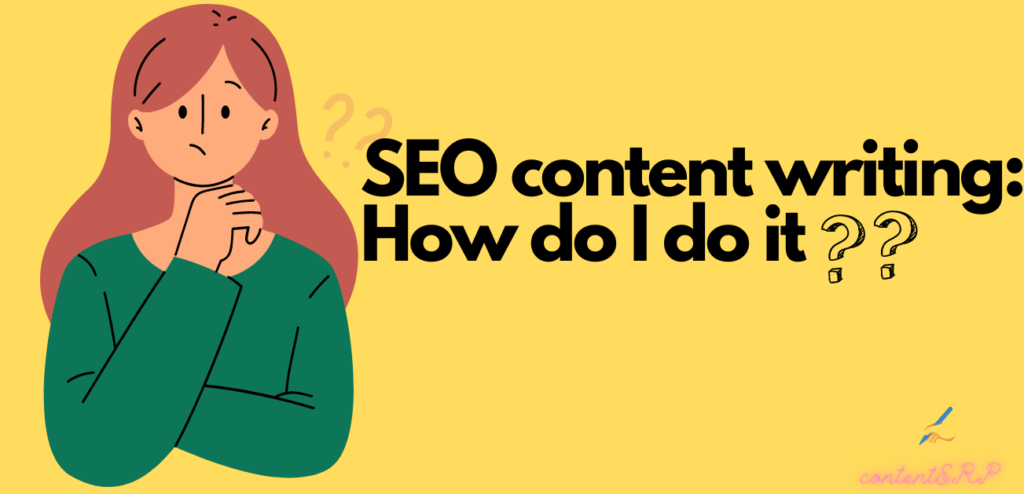How to do SEO content writing
So you want to write SEO content that gets picked up by search engines, that’s fantastic!
The web is a constantly growing and changing medium, and there’s always room for new voices. But before you start writing, there are a few things you need to understand about SEO content writing.

What Is SEO Content Writing?
In its simplest form, SEO content writing is the process of writing content that is optimized for search engines. This includes using keywords and phrases that people are likely to search for and ensuring that your content is informative and engaging.
But it’s not as simple as cramming in as many keywords as possible. Quality content is still essential, and you also must ensure that your content is well-written and easy to read. So how do you go about writing SEO-friendly content? It all starts with understanding the basics.
What Is SEO?
By now, we’re all familiar with what happens when you search for something on search engines. You type in a search term and then get a list of results that are relevant to your search term instead of a text snippet from the White House website.
This is a step-by-step description of the process, which encompasses search engine optimization (SEO). In a nutshell, SEO is a method of optimizing the effectiveness of your content for the search engines so that it ranks above content from other sites that target search terms similar to yours.
- You go through keyword phrases in a search engine, searching for certain topics on an infinite level of abstraction.
- You then select a specific keyword and go back to writing. You then write content that you want to share on other social networks.
- Google analyzes this content, following a Google algorithm that notifies your website of how authoritative your content is.
- Google then displays your site to users based on your authority and relevancy.
Understanding Copywriting
The process of copywriting emphasizes the transfer of ideas to an audience. Bruce Bendinger refers to the process of writing that leads the reader to take some action as copywriting. copywriting is salesmanship.
A copywriter is a skilled professional who writes copy to persuade customers, clients, prospects, readers, etc., to either purchase a product, subscribe to a list, take a test drive, or contact a salesperson. An online copywriter tailors this process to include marketing to persuade web users to buy products and services.
A copywriter is someone who knows how to use words to communicate with both human and robot readers. That means understanding both what readers like and what palatable words will appeal to them and their robots.
What’s in an SEO copy?
The copy typically consists of headlines, paragraphs, key sentences, paragraph subheadings, and titles. Suppose you’re a blogger, freelance writer, or online business owner. In that case, you can be a sought-after copywriter when you perfect your craft and develop a business that makes vanilla brands into delicious mealtime options that will lure your reader into a purchase.
Suppose you want your online business to be profitable. In that case, your job is to create useful content that is engaging, grounded, and well-optimized in your SEO in addition to being consistent. Every new structure carries weight when viewed from the outside at a unique point in time. Otherwise, search engines could not easily go forward creating new, “on-the-go” content that permits statistical control for SEO variability.

Steps to an SEO Content Strategy
To make sure your SEO is done properly, follow these steps.
Identify your goals
These are the methods you can employ to help achieve certain goals. Some aspects include finding a set of target keywords and ranking them with the possibility of reaching predetermined goals. Each object or document can be rated by quality. These objectives and quality rankings can help determine the grade.
Write for your readers
A proper SEO content writing strategy begins with understanding your reader demographic. What content are your readers looking for, and how do you engineer it so it meets their needs? SEOs put great emphasis on answering searcher queries and will rank content that satisfies this rule at the top of SERPs.
To know what your readers are looking for, step into their shoes by asking yourself these questions:
- What are they looking for when they type in a search query?
- What problem are they trying to solve?
- What solutions do they want?
Research keywords and validate ideas
Who are your target customers? What kind of website can you build to address their needs specifically? We suggest starting with a seed keyword and researching variations and questions around that seed keyword.
Tell a story
Tell a brand story but also indicate how it makes an impact. Brand storytelling can be used to gain attention because humans often like stories. Storytelling is not something exactly new because several brands have used it in the past and still do.
When you combine your brand’s story with natural storytelling, readers are willing to pay more attention to the content.
A great example of a brand story by Marcus Sheridan is one about Lego. According to him, Lego doesn’t sell blocks but rather the possibilities that a block holder can create with it. Your story shouldn’t be about you, however, but rather let others know about the possibility of achieving a similar result.
Impactplus: the best example of storytelling
Storytelling can change the outcome of three aspects of your SEO campaign:
- Your organic ranking
- Keyword rankings and traffic
- The conversions resulting from your online campaigns.
Use Case Studies
Being effective in inbound marketing requires properly writing content to serve each of those audiences, in addition to the option to provide some sort of traffic flow. Writing eye-grabbing case studies are a good way to improve your rankings for long-tail keyword phrases.
Market research indicates that companies that have found success and have generated case studies rank in Google’s top 10. When writing case studies, be sure to research your keywords thoroughly.
It is best to explain your product or service and conduct studies and experiments to find true-life examples that prove your claims. You’ll also need to write well and consistently.
Explore the option of writing with a firm in SEO; they can assist with optimization, analytics, and traffic.
You can share any type of case study, including those that did not result in the results you hoped for.
Link building
It is possible to affect SEO efforts by persuading a site to use your keyword in a link they create. You then reach out to affiliate or partner websites, provide value, and ask if they want to share or link to you.

These partners may recommend you if you own content offering better resources. You eventually succeed; that may be all you need to get the word out.
Create an editorial calendar and content briefs
If you want your content to rank in search engines, you need to plan it and create a calendar system for writing, uploading, and updating content.
A calendar schedule helps you track what’s supposed to be done and when. A plan takes the crazy out of manic writing and will also help you find time to do other SEO activities like going through your website analytics.
A lack of a proper schedule is what makes many SEO content strategists feel like SEO is too complicated with too many facets to focus on. Investing in a good schedule planner will help you write better and maintain your sanity.
Add keywords strategically in your SEO content
Search engines use keywords as a reference point when filtering results. It is important to make sure that you know how to use keywords in your content in the right way so it has a better chance of being found, indexed, and ranked.
On average, you should feature the primary keyword phrase in;
- The title tag of the title tag. This is the first element search engines and users look to inform them about the content of your page.
- The meta description. Gives a brief description of the content. Think of it as free advertisement to get those readers clicking on your site URL.
- The body of text. Depending on the content length, keywords should be used strategically throughout the body of the text. The ideal number is using them five times or more. Use LSI keywords as well in the body to avoid too much repetition of the main keyword and help with ranking for similar words.
- Images and other visuals. Using the main keyword in the image alt text of your visuals will help with better ranking.
Break text by adding helpful visuals
Visuals help clarify and distinguish pieces of information while creating a space for retention. Better readability helps keep motivated readers on the wiki.
Plus, other websites may incorporate pictures you’ve created and link back to your work. This forms the foundation of earning links from other sources that can increase your visibility in search results.
The inverted pyramid style
Your readers will need to know what you mean quickly, so don’t waste space with unnecessary details on the doorstep. Some may not even read through the rest of the content. Further elaboration in the body of your page may only help your site appreciate steadily.
Web articles, like a blog and other non-fiction, that must answer visitor questions should identify information at the beginning and end. It can be an excellent way to introduce your ideas to your target audience.
Conclusion: SEO copywriting is a process
Writing content for search engines can be done daily, weekly, or monthly. You don’t need to be a natural writer to “self-publish” content for SEO in this way. Remember to visit your content periodically to make sure it’s not outdated, stale, or formal.
The most important advice we could give about SEO content writing is to be yourself and keep writing. Use your own voice and writing style. We assure you that there’s space for everyone’s voice to be heard, no matter how saturated the industry may seem: there’s a person out there waiting to interact with what you have to offer.

